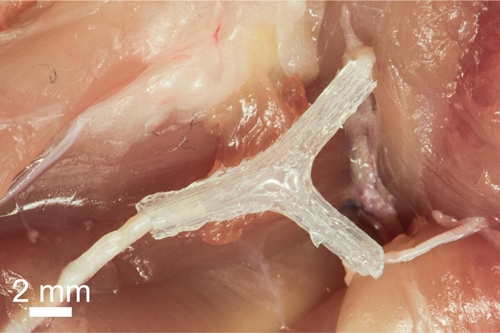
3-D printed nerve regeneration guide implanted in a rat (University of Minnesota College of Science and Engineering)
18 September 2015. Researchers from medical and engineering faculties at five universities in the U.S. developed a technique combining three-dimensional printing with tissue regeneration to grow new peripheral nerves in lab rats. The team led by mechanical engineering professor Michael McAlpine at University of Minnesota in Minneapolis published its findings today in the journal Advanced Functional Materials (paid subscription required).
McAlpine — with colleagues from Virginia Tech, University of Maryland, Johns Hopkins University, and Princeton University — sought a technique to help regrow sensory and motor nerves, a difficult process that makes nerve regeneration rare, often resulting in permanent nerve damage. The complexity of nerve regeneration is compounded by the need to custom-design each repaired nerve to fit the missing or damaged piece.
McAlpine and associates devised their technique first by 3-D scanning the anatomy of the recipient, in this case a lab rat induced with sciatic nerve damage, a missing gap of about 10 millimeters, and from that scan reverse-engineering an image model for regrowing the damaged nerve. The damaged sciatic nerve had two branches, for sensory and motor signals, resulting in a Y-shaped model.
The model was used to generate a silicone pathway or guide to grow the nerve with a specialized 3-D printer, further customized for this task. The silicone in the guide had microgrooves to hold the nerve fibers, infused with biochemical factors, such as proteins, to feed their growth. The scanning and printing of the nerve guide took about an hour.
The team implanted the guide in the rat, grafted to both ends of the gap in the sciatic nerve. The damaged nerve limited the rat’s ability to walk, but the animal’s ability to walk improved within 10 to 12 weeks following the implant.
The researchers say the proof-of-concept study advances nerve regeneration technology by customizing the design of a replacement part with computational modeling, as well as integrating biochemical functions into the production of that new part. In addition, the new piece produced by the process was a more complex, Y-shaped nerve for transmitting motor and sensory signals, rather than single linear nerve fibers as was done previously.
“Someday,” says McAlpine in a university statement, “we hope that we could have a 3-D scanner and printer right at the hospital to create custom nerve guides right on site to restore nerve function.” The following brief (30 second) video shows the 3-D printer producing the guide with biochemical factors infused in the material.
- Wireless Light-Activated Circuit Connects to Mice Neurons
- Injectable Neuro-Electronic Wire Mesh Demonstrated
- Calico Licenses Neurodegenerative Disease Compounds
- Paralyzed Man Moves Hand with Neuro-Signal Implant System
- Neurodegenerative Therapies Start-Up Gains $4.8M Seed Funds
* * *

 RSS - Posts
RSS - Posts
[…] 3-D Printed Guide Devised to Regrow Nerve Fibers […]